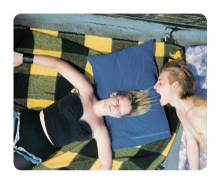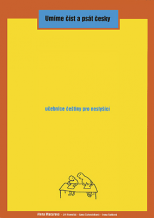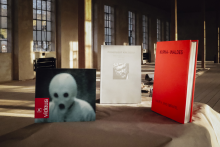| Umělec 2003/3 >> KOSOVO GYPSY ART: a medium for survival | Просмотр всех номеров | ||||||||||||
|
|||||||||||||
KOSOVO GYPSY ART: a medium for survivalUmělec 2003/301.03.2003 Paul Polansky | focus | en cs |
|||||||||||||
|
"Paul Polansky is the author of 14 books, of which eight are about the Roma. Since 1991 he has lived with the Roma in the Czech Republic and Kosovo. He is co-founder of the Kosovo Roma Refugee Foundation and he is currently living in Pristina, Kosovo. His last book about the Kosovo Gypsies, TO UNHCR, WITH LOVE, was published by Divus and Jejune Ultima in September 2003.
For 12 weeks this past summer I monitored for Society for Threatened Peoples, a German human rights organization, the plight of almost 700 Gypsy refugees stranded on the Macedonian-Greek border. They had escaped four years earlier from Kosovo after Albanian extremists returning with the NATO forces looted and burned more than 14,500 Gypsy homes, forcing more than 100,000 to flee. I knew these 700 refugees rather well since I had lived with them in their first camp in Kosovo from July to September 1999 before they escape to Macedonia. Although communication was difficult (they knew no English, and I knew no Albanian, no Serbian, only a smattering of Romanes), they showed me with naive drawings what had happened to them. No one was an artist. Most were day laborers with only a primary school education. But all felt a need to demonstrate their tragedy. Some even found watercolors to paint a more vivid picture. I was the only non-Gypsy1 living in their camp 24 hours/day. Because I had written several books on the Czech Roma, I was asked to advise UNHCR on how to cope with these unwanted Gypsy IDPs. As an author, I was more interested in their stories, their oral histories, and their love for poems. But for three months all they wanted to do was show me why they were now in an IDP camp. On napkins, on paper salvaged from aid packages, on ripped-up cardboard boxes, they drew their pictures of men in black uniforms wearing black masks and carrying guns, knives and axes, chasing them out of their homes which were always in flames. Children as young as five and six drew the most vivid pictures, showing their dead dogs in streets running with blood. Older children drew pictures of themselves running away in their pajamas, or escaping with overstuffed suitcases in a small wagon pulled by a skinny horse. The adults usually added to their pictures a NATO plane dropping bombs. I don’t know what became of those pictures. I tried to buy them, but everyone wanted to keep their own drawings as a reminder of what had happened to them. I suspect all were lost when these IDPs marched out of their first camp for Macedonia, seeking better security. Although a British KFOR commander had promised in person that they would be protected, an English colonel withdrew his soldiers one night while all the Gypsies were asleep, never to return. UNHCR was reluctant to allow me to sleep with the Gypsies since UN police had received intelligence reports that Albanian extremists in their drive to ethnically cleanse Kosovo of all minorities were planning to attack the camp. But I talked the authorities into letting me stay, and witnessed several attacks by Albanians sneaking into the camp at night slashing the sides of many tents with long knives. The next day drawings of those attacks were produced as “proof” of what had transpired during the night. Unfortunately, the UN police never accepted those pictures as evidence and concluded the Gypsies must have slashed their own tents to frighten their own children! When the Gypsies left, I marched with them, and after suffering several attacks on the same highway the Albanians had used to escape from the Serbs, the Gypsies abandoned most of their suitcases (filled with their clothes and drawings) as sunstroke and thirst overtook them. After four years in Macedonia, without being granted refugee status and with UNHCR and the Macedonian government trying to force them back to Kosovo where they no longer had a home, the Gypsies abandoned their camp (after UNHCR had cut off their water and electricity and stopped all food aid), hired buses, and headed for Euro land. Once on the frontier they were surrounded by Macedonian border police who tried to force them back on the buses. On the other side of the border, it was rumored that the Greek army had mobilized tanks and special commandos in case the Gypsies tried to force their way in. Thus began a 12-week standoff. Although I had kept in contact with these Gypsies over the years, I was not aware of their intention to escape to Greece until I heard about it over the radio. Within 48 hours I drove from my office in Kosovo to the Greek border to see what was happening. I was greeted with one of the most depressing sites imaginable. The Gypsies were “contained” in the Macedonian-border parking lot. They had no food, no water, no tents. But knowing they might have to camp out while waiting for permission to escape as war refugees, most had brought plastic sheets or blankets which they propped up with sticks and branches from newly trimmed trees alongside the road leading up to the border. For 12 weeks this was their only shelter from sun, cold nights, and frequent rainstorms. The only tent UNHCR supplied was for the Macedonian doctor who came every day to hand out aspirin for sunstroke. Although their plight was reported in the national press (the BBC even made a short news film about them) few came to their aid. UNHCR, still trying to force them back to Kosovo, allowed only one NGO to bring them supplies: one liter of water and one loaf of bread per person per day. All other necessities requested by the Gypsies (such as sanitary pads for their women) were refused. Once a week I drove down from Kosovo to spend the weekend with these outcasts. At first I thought their stay would be for only a few days, a few weeks at the most. There was no shade to get them out of the hot summer sun, and at night they had few blankets to keep them warm as the cold wind rushed down from the surrounding mountains. Many of the women vomited several times a day from sunstroke. Five babies were born on the border, but UNHCR still refused any extra aid. When I saw the Gypsies were determined to die on the border unless their four-year-old refugee problem was solved, I started to write poems about their plight. Then I asked permission from the Macedonian police chief on the border to take photos. He refused. In fact, I was warned if any of his police saw me with a camera, it would be confiscated. So remembering how these same Gypsies had documented their plight four years earlier in Kosovo, I drove into the nearest town and bought several blocks of drawing paper, pencils, bushes and water colors and started handing them out to anyone who felt they could draw. After one week, I returned to find that six or seven Gypsies (from a 15-year-old boy to a 48-year-old camp leader) had produced several drawings each. Even one of the women, a 22-year-old Ashkali,2 had painted two watercolors. The pictures ranged from satirical political cartoons about their inhumane conditions to landscapes showing the picturesque mountains nearby. All of the drawings were naive, even crude, but most packed a powerful punch. It was their story and they were telling it (painting it) with great emotion. Because everyone in the camp was always hungry, I bought all their pictures then took “the artists” in my car to the local market so they could buy food for their families. Since each Gypsy was part of a clan with 20 to 30 members, the artists were able to support all Gypsies, no matter if they were Roma, Ashkali or Egyptian. For the next ten weeks I visited my Gypsy artists every weekend, taking what aid I could, but more importantly, buying all their “artwork” at 20 euros each. No matter what they produced I bought their drawings to encourage them to tell their own story in the only way they knew how. Several young children also tried to draw and paint their experiences of life on the border. But usually their attempts turned out to be a traumatic recollection of being forced out of their homes four years ago. One of my poems, later published in the book I wrote about their “summer camp,” reflects their postwar traumatic state: PAINTINGS ON THE BORDER I’ve asked several children and several adults to paint me pictures of their life on the border. The police won’t let anyone take a photo so I thought I’d capture the scenes of their camp with their drawings. But when I collected the water colors from the children, there were no scenes of the camp. No scenes of the snow-capped mountains. No scenes of the children playing their old Gypsy game of horse and driver. Neither were there any scenes of the Gypsy mothers hanging their washed clothes on the police barricades. The only scenes the children had painted were of their homes in flames four years ago black uniformed soldiers in ski masks chasing Gypsies down the street homes on fire, cars on fire dead dogs lying on the lawns their blood running like a river. When I asked 15-year-old Arton why he hadn’t painted their camp on the border he stared at his picture for several seconds and said, I thought I had. Although the Gypsies’ struggle to escape from Macedonia failed (after 12 weeks they were transported back to Shutka and crammed into private housing, an average of eight people per room), it was not a lost cause. Their art, which was reproduced in my book, TO UNHCR, WITH LOVE, has attracted a lot of notice as an exhibition at my poetry readings in Macedonia, Germany, the Czech Republic, and Switzerland. A Swiss diplomat is now buying their works on a weekly basis, and a museum in Germany has scheduled an exhibition of their paintings in 2004. With no jobs and little humanitarian aid, these Gypsy painters — Musa Shakiri (48), Sebahate Brahimi (27), and Driton Berisha (19) with their works shown here, and the other Romani artists who continue to produce for us and who will be in the exhibition in Switzerland Besim Berisha (27), Ilir Brahimi (20) and Veton Brahimi (21) — were now down to a semi-professional group of six, and are still supporting their family clans with their artistic protest. Although UNHCR has demonstrated a low opinion and a very low tolerance of “Gypsy refugees” the public can now see that these Kosovo Roma, Ashkali and Egyptians have a story to tell. And they are telling it in an art form that is getting more recognition and sympathy for their people with each exhibition. Tomorrow they may well become the artists of the moment. 1. Although the term “Gypsy” may be politically incorrect or even offensive to some, I use it here because in Kosovo there are many “Gypsies” who would fight you if you called them Roma, such as the Ashkali, Egyptians and Serb-Roma. For many in Kosovo today, the term “Roma” means a Gypsy who collaborated with the Serbs. 2. Ashkali are Gypsies whose Roma ancestors moved into Albanian villages and took up the Albanian customs, traditions and language but never integrated or married into Albanian society. Today most Ashkali speak only Albanian but many of them remember their grandparents also spoke Romanes. There are about 14 different Romani clans/castes/tribes in Kosovo today; normally they do not intermarry. "
01.03.2003
Рекомендуемые статьи
|
|||||||||||||
|
04.02.2020 10:17
Letošní 50. ročník Art Basel přilákal celkem 93 000 návštěvníků a sběratelů z 80 zemí světa. 290 prémiových galerií představilo umělecká díla od počátku 20. století až po současnost. Hlavní sektor přehlídky, tradičně v prvním patře výstavního prostoru, představil 232 předních galerií z celého světa nabízející umění nejvyšší kvality. Veletrh ukázal vzestupný trend prodeje prostřednictvím galerií jak soukromým sbírkám, tak i institucím. Kromě hlavního veletrhu stály za návštěvu i ty přidružené: Volta, Liste a Photo Basel, k tomu doprovodné programy a výstavy v místních institucích, které kvalitou daleko přesahují hranice města tj. Kunsthalle Basel, Kunstmuseum, Tinguely muzeum nebo Fondation Beyeler.
|




































 We Are Rising National Gallery For You! Go to Kyjov by Krásná Lípa no.37.
We Are Rising National Gallery For You! Go to Kyjov by Krásná Lípa no.37.
Комментарии
Статья не была прокомментированаДобавить новый комментарий